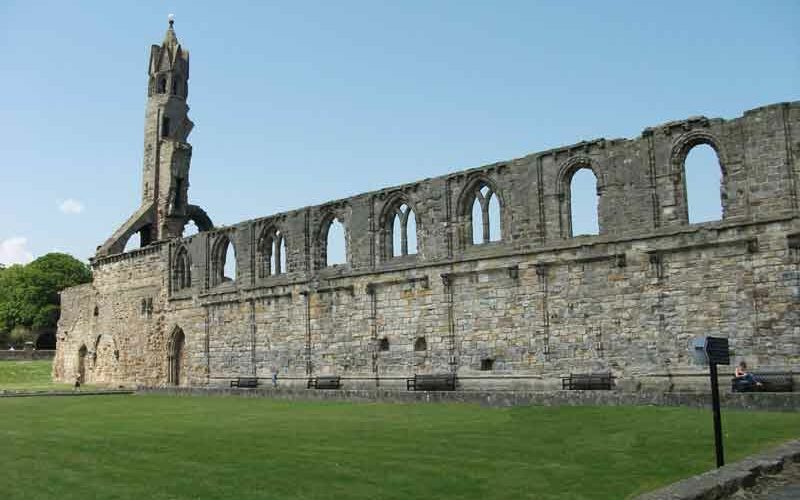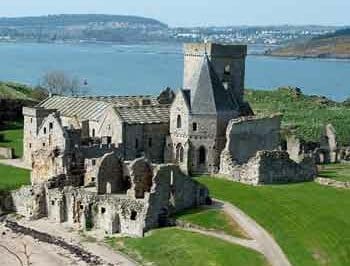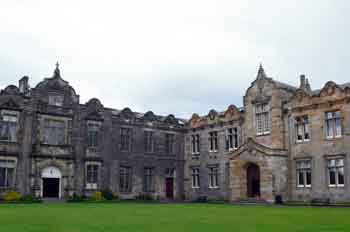
Many of Scotland’s early chronicles survive only as transcripts, thanks to the commitment of a few dedicated scribes and archivists.
Originals have been stolen or destroyed by conquering armies or simply disappeared through the passage of time.
For example, in 1296, during the Wars of Independence, records were taken by Hugh Cressingham, Treasurer of Edward I and almost certainly transported to London.
There were other similar examples in later centuries.
The scarcity of historical documents makes those that survive, in whatever form, all the more precious – they are the lifeblood of research and the basis of scholarly historical writing.
The Scotichronicon by Walter Bower
Today the Scotichronicon written by Walter Bower (1385-1449) building on earlier work by John (of) Fordun (d. c. 1363), is foremost in extant records.
It is the story of Scotland from its origins to the middle of the 15th century.
The National Library of Scotland (NLS), has a printed edition (Latin) dated 1722.
It was produced, it says, from manuscript sources, describes the work as, “probably the most important medieval document of early Scottish history.
It provides a strong expression of national identity and offers a window into the world view of medieval commentators.”
The Advocates Library in Edinburgh has an abridged copy known as the Book of Cupar.
Today those with an interest in Scotland’s past have the luxury of a more recently edited Scotichronicon.
This is thanks to the work of Professor Donald Watt, (general editor) an eminent Scottish historian, and a small group of distinguished colleagues.
Written in Latin and English and compiled between 1987 and 1998 this nine-volume edition is based on an original manuscript from Corpus Christi College at the University of Cambridge.
It’s a magnificent document, described as a working copy, written in Latin by a scribe under the direction of Walter Bower.

What sort of men were Fordun and Bower and what made them dedicate much of their life to the chronicling of Scotland’s history?
It was Bower’s submission that Fordun was motivated by the lack of available information on Scotland’s past.
He suggested that it was related to Edward I’s policy of destruction in Scotland.
For Fordun the answer is much simpler – he was asked to do it.
Chronicler John of Fordun
John of Fordun was a chaplain at Aberdeen Cathedral although it seems that his relatively lowly position meant that his name was never recorded in the Cathedral records.
A contemporary described him as an “undistinguished priest, not a product of any of the schools.”
In contrast, Professor Watt was quick to argue that Fordun’s ability to embellish his writing with literary references was remarkable for a self-educated man.
Despite the caution and uncertainty over his version of events, there are few other sources for students of the period to turn to. Consequently, Watt concludes that “Scottish history without Fordun is literally unimaginable.”
According to Richard Finlay of Strathclyde University, it was “the first attempt at a reasonably comprehensive history of the Scots…”
Some of his sources are recognisable – ones also used by chronicler Andrew Wyntoun.
Among them are Geoffrey of Monmouth and the Venerable Bede who spent much of his life writing from the monastery at Jarrow in the northeast of England.
Although living many centuries before Fordun it’s unsurprising that some of Bede’s immense output, perhaps as many as 40 books including his Ecclesiastical History of the English People, influenced Fordun.
Descendants of Scota
Fordun, travelled extensively throughout England, Ireland and Scotland to collect his research.
His work, Chronica Gentis Scotorum, in five volumes, is wide-ranging and includes coverage of the Romans who he described as having a history of, sheer brilliance in comparison with all other histories – Britons, and Picts also make an appearance.
He includes what can best be described as folklore on the subject of Merlin’s involvement in Scotland and his own interpretation of the legend that Scotland was named after the descendants of Scota, the daughter of an Egyptian Pharaoh, and Gaythelos a Greek king who found their way first to Ireland and then to Argyll in Scotland.
These examples however are merely the tip of a fascinating iceberg.
The period covered by Fordun extended to the death of David I in 1153 and was probably written between c. 1371 and his death.
There are also a number of later notes added. For example, while examining the consequences of the Anglo-Scottish warfare of 1337 he said that much of Gowrie Angus and the Mearns were “reduced to a hopeless wilderness and to utter want.”
Encouraged by his neighbour and patron David Stewart of Rosyth, Bower was asked to update Fordun’s work.
In the Scotichronicon prologue, Bower wrote, “I have agreed to satisfy the urgent requests of the noble knight Sir David Stewart of Rosyth.
“That is to transcribe the following historical work recently and excellently begun by the venerable orator John Fordun, priest, clearly and elegantly written as a chronicle…”
Despite his obvious appreciation of Fordun’s work, he was accused on a number of occasions of being an “interpolator.” Among the disapproving voices raised was 19th century historian William Forbes Skene.
However, Donald Watt was quick to defend Bower by saying that he was simply doing the job he was asked to do.
He added that the Scotichronicon added up to something, “much more massive and stimulating than the comparatively primitive work of Fordun.” (Bower contributed around three times as much as Fordun.)
Interestingly Bower not only incorporated Fordun’s work he expanded the text, using new sources unknown or unavailable to Fordun and added a number of notes to it.
For example, the sections on Scottish saints – Baldred, Kentigern, Columba Aiden and Cuthbert were updated and improved.
More of Scotland’s History
- The Scottish Enlightenment
- Declaration of Arbroath
- Leith the Port of Edinburgh
- Early Glasgow History
There was however a certain inevitability that as the Scotichronicon gained prominence, Fordun’s standalone work would gradually disappear.
It was the aforementioned Skene who in 1871 successfully identified and published a new edition of Fordun’s work without the changes and additions made by Bower thus re-establishing it as a work in its own right.
This also ended a long period of confusion when editors were mistakenly attaching the Scotichronicon title to Fordun’s work.
In saying this, an Internet search today clearly shows a continued lack of understanding that the title Scotichronicon belongs to Bower alone.
Bower was a native of Haddington
Bower was born in Haddington in 1385, although little is known about his parents or his early childhood.
However, his writing shows a continued familiarity with Haddington which suggests he did spend his early years there and probably kept in touch with events, or family in the East Lothian village.
In c. 1400, he joined the community of Augustinian canons at St Andrews Cathedral as a novice.
He must surely also have been witness to or perhaps even taken part in the exuberant celebrations surrounding the establishment of Scotland’s first university.
For he wrote vividly about the occasion – of Bishop Henry Wardlaw’s charter of incorporation and the Papal Bulls of February 1414 which conferred full university status.
Almost certainly encouraged by Prior James Biset a graduate of Paris and Avignon in Canon Law, he enrolled at the recently established St Andrews University taking degrees in Canon Law and Theology
With his education, complete Bower was ready for a more senior position in the Augustinian order.
That promotion came in April 1418 when, still a young man of 32, he was blessed as abbot of Inchcolm Abbey.
During the two following decades, he did twice push unsuccessfully for the abbot’s position at the larger and wealthier house at Holyrood. In the end, he remained as abbot of Inchcolm for over 30 years until his death in 1449.
Abbot of Inchcolm Abbey
As abbot of Inchcolm Abbey, Bower also took on the mantle of ecclesiastical magnate and as such also had a political role with a duty to attend king’s councils and parliaments during the reign of James I.
James was a monarch who demanded frequent parliaments as a method of strengthening his royal authority, particularly in his attempt to destroy the Albany Stewarts, the family that held the regency during his long period of captivity in England.
Parliamentary records show he was a member of the king’s judicial committee and was involved in tax collecting, Bower’s patron David Stewart, having been knighted at the king’s coronation in 1424 was also part of the royal entourage.
Sadly only one record of Bower’s involvement in politics still exists. This is a record of a debate in October 1433, to discuss a response to a “peace embassy” from England.
Ultimately, the approach from England was rejected because of Scotland’s prior commitment to France.
It was only two years before that Bower was in Paris to negotiate the marriage between James I’s daughter Margaret to the Dauphin of France.
Following the king’s death in 1437, Bower continued his state duties during the minority of James II although from 1440 he spent much more time on Inchcolm working on the Scotichronicon.
Inchcolm Abbey is set on the Island of Inchcolm in the Firth of Forth, within sight of Edinburgh, and is today managed by Historic Environment Scotland (HES).
The Augustinians, attracted by the peaceful location were resident on the island from the beginning of the 12th century.
That peace was subsequently swept away by English naval raids during the wars which stretched from the early 14th century to the mid-16th century. The Protestant Reformation of 1560 brought monastic life to a close.
Comforting sentences from the warming room at Inchcolm Abbey,
For students with a particular curiosity about Bower and the Abbey’s history the paper Comforting Sentences from the Warming Room at Inchcolm Abbey, by academics Davies, Sharpe and Taylor offers some intriguing additional information.

Unlike Fordun there are no records of Bower travelling outside Scotland other than a possible journey to the English regions on the Welsh border.
However, he does mention the library of the Dominican friars in Edinburgh and he possibly also researched the English chronicles held in Edinburgh Castle.
He almost certainly consulted some of the, now lost, chronicles kept in the St Andrews Cathedral library.
Walter Bower was never afraid to expand on some of his favourite topics. Indeed, his chronicles were always much more than just a sterile list of dates and events.
There are times during the writing process when Bower dons his preacher’s hat and writes from a religious or personal perspective producing tales with a moral point.
This approach earned him the epithet of “historian-come-moralist.”
It’s a fairly extensive list but the dangers of royal minorities featured as did the nature of good governance.
He heaps praise on Alexander III, particularly for his work to persuade foreign merchants to settle in Scotland, portraying him, said RR Davies writing in the English Historical Review, as the embodiment of strong and effective kingship.
While there was an obvious affection for Alexander, Bower wasn’t afraid to be critical. For example, the king’s seizure of the goods of Bishop Gamelin of St Andrews, at one point chancellor to Alexander and Papal chaplain, was roundly condemned.
French Dominican friar, Vincent Beauvais
The Scotichronicon also examined European history and freely used, mostly without attribution the work of the remarkable French Dominican friar, Vincent Beauvais, the author of the Speculum Maius encyclopaedia.
This immense work (16 books) allowed Bower to dwell at some length on what was essentially non-Scottish material including some of the 13th century popes, French kings and Fredrick II the Holy Roman Emperor, a man he described as a, “very great tyrant.
“A full two chapters were dedicated to the life of King John of England and others from the House of Plantagenet.
One commentator noted that Bower had proved, “at least to his own satisfaction that the kings of England were descended on one side from the family of the devil.”
However, it was clear that he believed that events in Scotland could not be viewed in isolation and could only be properly understood in conjunction with what was unfolding in Europe.
In saying this, his early draft was much lighter in terms of continental news but after some encouragement, he expanded the text. Certainly, his patron Sir David Stewart supported this approach.
Mystical writer St Bridget of Sweden
Other 14th century sources included the influential Dominican scholar Robert Holkot, mystical writer St Bridget of Sweden, founder of the Augustinian Brigettines nuns and monks and Martin Troppau, Dominican friar and chronicler.
Bower also uses a liberal sprinkling of Biblical quotations to reinforce some of his arguments and was unafraid to make reference to the corpus of canon law – unsurprising considering his university background.
One observer said of Bower “He was not just a chronicler preserving all that he could find about the past: he was a sage through whose wide-ranging reflections much can be learned about the customs and attitudes of his time.”
For those with knowledge of Latin, studying the Scotichronicon manuscript at Corpus Christi would surely provide a challenging and evocative experience. However, for the majority, Professor Watt’s widely available English edition is the better option.
Commenting on the work, Michael Brown, writing in the Scottish Historical Review said, “For sheer organisation, persistence and unity of purpose Professor Watt and his team have managed something remarkable…”
Professor Watt said “He was more and more convinced that this book is one of the national treasures of Scotland, which should be studied in depth for many different kinds of enquiry into Scotland’s past.”
REFERENCES: RESEARCH AND DATA
Michael Lynch (ed), Oxford Companion to Scottish History (OUP) 2001. Sections relating to Walter Bower Historians, Historical Sources, National Identity.
RA Houston, WWJ Knox (Eds) The New Penguin History of Scotland (Allen Lane, Penguin Press) 2001.pps 72-3, 76-8, 82, 98, 106-7, 152.
National Records of Scotland: Scotichronicon, accessed February 2022.
University of St Andrews, Scotichronicon: in Latin and English. accessed November 2021.
D. E. R. Watt, Bower [Bowmaker], Walter, Oxford Dictionary of National Biography 2006. (library card needed). Accessed November 2021.